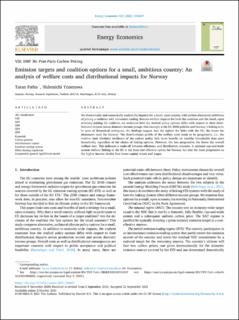| dc.contributor.author | Fæhn, Taran | |
| dc.contributor.author | Yonezawa, Hidemichi | |
| dc.date.accessioned | 2022-03-24T17:52:28Z | |
| dc.date.available | 2022-03-24T17:52:28Z | |
| dc.date.created | 2021-11-08T09:58:26Z | |
| dc.date.issued | 2021 | |
| dc.identifier.citation | Energy Economics. 2021, 103 . | en_US |
| dc.identifier.issn | 0140-9883 | |
| dc.identifier.uri | https://hdl.handle.net/11250/2987487 | |
| dc.description.abstract | We theoretically and numerically analyse the impacts for a small, open country with carbon abatement ambitions of joining a coalition with allowance trading. Besides welfare impacts for both the coalition and the small, open economy joining the coalition, we scrutinise how the studied policy options differ with respect to their distributional impacts across domestic income groups. Our example is the EU 2030 policies and Norway's linking to it. In spite of theoretical ambiguity, the findings suggest that the tighter the links with the EU, the lower the abatement costs for Norway. The distributional profile of the welfare costs tends to be progressive, i.e., the relative (and absolute) incidence of the carbon policy falls more heavily on wealthy households than poor households, regardless of the choice of linking options. However, the less progressive, the lower the overall welfare cost. This indicates a trade-off between efficiency and distribution concerns. A national cap-and-trade system without linking to the EU is the least cost-effective option for Norway but also the most progressive as the higher income deciles face lower capital return and wages. | en_US |
| dc.language.iso | eng | en_US |
| dc.publisher | Elsevier | en_US |
| dc.rights | Navngivelse-Ikkekommersiell-DelPåSammeVilkår 4.0 Internasjonal | * |
| dc.rights.uri | http://creativecommons.org/licenses/by-nc-sa/4.0/deed.no | * |
| dc.title | Emission targets and coalition options for a small, ambitious country: An analysis of welfare costs and distributional impacts for Norway | en_US |
| dc.type | Peer reviewed | en_US |
| dc.type | Journal article | en_US |
| dc.description.version | publishedVersion | en_US |
| dc.rights.holder | © 2021 The Authors. Published by Elsevier B.V. This is an open access article under the CC BY licens, 4.0. | en_US |
| dc.subject.nsi | VDP::Samfunnsvitenskap: 200::Økonomi: 210 | en_US |
| dc.source.volume | 103 | en_US |
| dc.source.journal | Energy Economics | en_US |
| dc.source.issue | November 2021 | en_US |
| dc.identifier.doi | 10.1016/j.eneco.2021.105607 | |
| dc.identifier.cristin | 1952201 | |
| dc.source.articlenumber | 105607 | en_US |
| cristin.ispublished | true | |
| cristin.fulltext | original | |
| cristin.qualitycode | 1 | |

